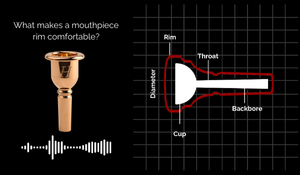What makes a mouthpiece rim comfortable?

The rim is the part of the mouthpiece that physically contacts our face. As a result, it is the part of the mouthpiece that effects our comfort most. So what makes a rim comfortable?
The adjectives connected to your rim description generally include wide/narrow and rounded/flat. While playing experience with these options is unique to each individual, these options are generally associated with providing more stability or more flexibility.
Imagine sitting on a wooden box in the middle of a room, you are well supported and will not tip over easily if I give you a little nudge. However, you will have a difficult time moving on that box to the far side of the room. If I ask you to sit on a balance ball in the middle of the room, it will take more physical energy to maintain your balance, but moving to the other side of the room would not be a problem.
Let’s take this analogy back to the rim. A wider, flatter rim can provide extra support to your embouchure, but may cut into your flexibility. A narrow/rounded rim can provide you a lot of flexibility but will potentially take greater physical control to keep your tone and tuning stable.
You can vary it as well. You might want extra support and flexibility and find a wide rim that is slightly more rounded. Here are some insights from the Denis Wick artist group on what type of rim they like to play on and how it supports them.

Join the Denis Wick Community by signing up to receive the Denis Wick Tips blog updates, and find all of our resources in one spot on the Denis Wick App.
Preston Bailey, American Classic 3C
I play on the American Classic 3C, and it's the happiest I've ever been with my orchestral sound. I switched to the American Classic because I needed help with consistency in my attacks, particularly in the low register.
The month I made the full time switch I performed as principal trumpet in the Huntsville and Chattanooga Symphonies, as well as principal for the Nashville Ballet's Nutcracker run, and I received so many compliments about my playing that I knew I'd found my mouthpiece!
What I like specifically about the rim is how comfortable it is, even after a 7 hour day in a recording studio or a dress rehearsal and a concert of all John Williams! It's flat enough that I don't worry about swelling up and not fitting in the mouthpiece. It also increases my endurance and allows me consistent range from low F to high E, which is plenty for what I do!
Justin Gruber, Tuba, Aaron Tindall AT3 Ultra Mouthpiece
I play on the AT3! The special attention to detail in every way trains me to be consistent in my physical and sonical setup. The design of the AT line is analogous to a robust dog trainer. It will put me in line, show me when I need to change, and not accept anything it does not like, similar to Aaron's successful style as a competitive dog trainer for many years. This consistency in the mouthpiece line's rim secures my muscles to memorize and engage the same way every time. This is helpful for orchestral repertoire as I feel comfortable picking up a cold horn with an AT mouthpiece in the receiver.
Kirk Garrison, Trumpet, Maurice Murphy MM4C
MM4C - Extremely versatile mouthpiece. The rim and cup size are a perfect fit for the kind of playing I do. Upper register is excellent for lead playing (2 + hour shows), sounds wonderful in the staff (where we all live the most) with a rich beautiful sound in a small group jazz combo or a brass quintet. Articulation, whether in a classical or jazz style are accomplished with ease. I play a Schilke B-5. I also use the MM4C on my Yamaha Custom piccolo trumpet. Since the Yamaha takes a regular mouthpiece shank, it works great!
Kate Amrine, Trumpet, American Classic Ultra 3C
I love the roundness of the rim and how it feels comfy on my face. I also love that I can use the same size mouthpiece for my flugel and Eb and even my 4X on piccolo feels similar rim wise.
Follow Kate on Instagram: @Katetrumpet




